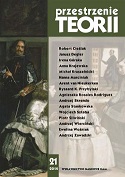„Śmierć w starych dekoracjach”, czyli „aisthesis” według Tadeusza Różewicza
Death in the Old Decorations, i.e. aisthesis, according to Tadeusz Różewicz
Author(s): Irena GórskaSubject(s): Theory of Literature
Published by: Uniwersytet Adama Mickiewicza
Keywords: Tadeusz Różewicz; literature; aesthetics; sensory experience; Aisthesis;
Summary/Abstract: The aim of this article is to present Różewicz’s way of thinking about the concept of aisthesis based on his short story Śmierć w starych dekoracjach [Death in the Old Decorations]. Różewicz, who follows current trends in aesthetics which appreciate the role that the body and all of the senses play in an aesthetic experience, ennobles the very body that remains a center of sensory and aesthetic perception, in accordance with Richard Shusterman’s somatic philosophy. However, Różewicz’s character, who starts with simple sensory impressions, constantly goes beyond the senses and provides a commentary on each new ordinary, everyday experience as well as an experience of art. These commentaries are constructed from memories, images, reflections or free digressions which are often very remote from what they were triggered by. Różewicz emphasizes both the importance of what is rational and what is sensory for an aesthetic experience, thus overcoming a belief which was promoted by traditional aesthetics, i.e. about the exceptionality of psychological attitudes to aesthetic experiences. He extends aestheticism to include areas that are traditionally considered to be unaesthetic in order to capture the full essence of aisthesis. Therefore, he does not differentiate between the experience of art and ordinary, everyday experiences. This is because aisthesis in Śmierć w starych dekoracjach is a force that merges all these experiences into one whole, thus turning an experience of art into an experience of existence.
Journal: Przestrzenie Teorii
- Issue Year: 2014
- Issue No: 21
- Page Range: 181-194
- Page Count: 14
- Language: Polish

